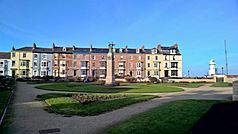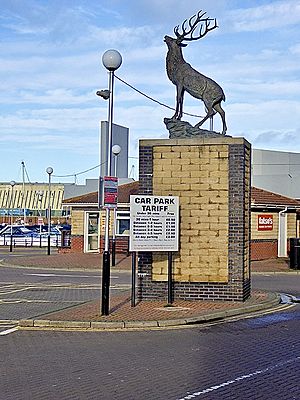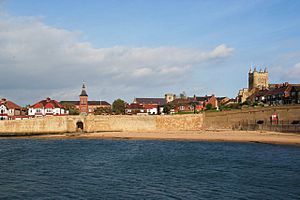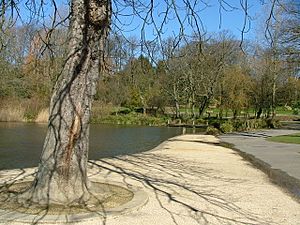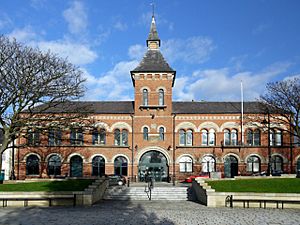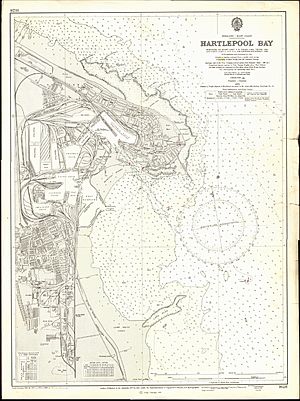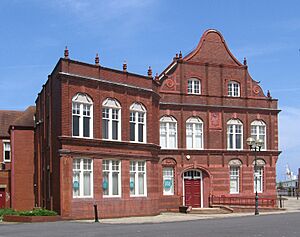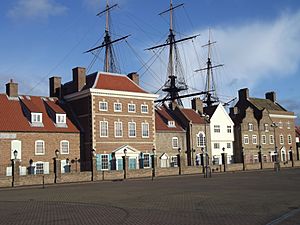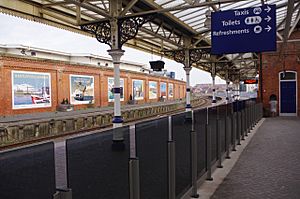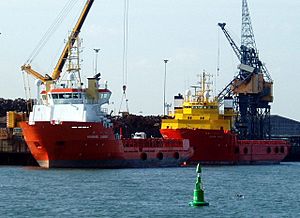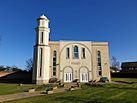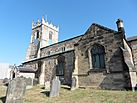Hartlepool facts for kids
Quick facts for kids Hartlepool |
|
|---|---|
| Town | |
|
The Headland, St Hilda's Church, Victoria Road, the Marina and Christ Church Art Gallery |
|
 A Hart (red stag) |
|
| Population | 92,600 |
| Demonym | Hartlepudlian |
| OS grid reference | NZ508331 |
| • London | 261 miles (420 km) |
| Unitary authority |
|
| Ceremonial county | |
| Region | |
| Country | England |
| Sovereign state | United Kingdom |
| Post town | HARTLEPOOL |
| Postcode district | TS24–TS26 |
| Dialling code | 01429 |
| Police | Durham |
| Fire | County Durham and Darlington |
| Ambulance | North East |
| EU Parliament | North East England |
| UK Parliament |
|
Hartlepool is a seaside and port town in County Durham, England. It is run by a special local government called a unitary authority borough, which is named after the town. This borough is part of the Tees Valley area. Hartlepool has about 92,600 people, making it the second-largest town in County Durham, after Darlington.
The old town of Hartlepool started in the 600s. It grew around a monastery on a piece of land sticking out into the sea. In the Middle Ages, its harbour was the main port for the area known as the County Palatine of Durham. A new town, West Hartlepool, was built in 1835. This happened after a new port was made and railway lines connected it to coal fields and other towns.
In 1967, the old town and West Hartlepool officially joined to become one borough called Hartlepool. Today, the main town centre and train station are in what used to be West Hartlepool. The old town is now usually called the Headland.
Because of its growing industries like shipbuilding in the late 1800s, Hartlepool became a target during the First World War. On December 16, 1914, the German Navy attacked the town with 1,150 shells. This attack killed 117 people. After the Second World War, many heavy industries and shipbuilding businesses closed down. This led to high unemployment until the 1990s. Then, big projects and the rebuilding of the docks into a marina helped the town get better. Hartlepool also has a seaside resort called Seaton Carew.
Contents
- History of Hartlepool
- How Hartlepool is Governed
- Geography of Hartlepool
- Hartlepool's Economy
- Culture and Community in Hartlepool
- Transport in Hartlepool
- Education in Hartlepool
- Religion in Hartlepool
- Sports in Hartlepool
- The Hartlepool Monkeys Legend
- Famous People from Hartlepool
- Local Media in Hartlepool
- Twin Towns
- Images for kids
- See also
History of Hartlepool
The name Hartlepool comes from old English words. Heort means "stag" (a male deer), and pōl means "pool." So, it means "pool of drinking water where stags were seen." Old records show names like Heretu (649) and Herterpol (1017).
Early Settlement on the Headland
In the 600s, a settlement grew on a headland overlooking the North Sea. It was around an abbey started in 640 by Saint Aidan, an Irish priest. The monastery became very important under St Hilda, who was its leader from 649 to 657. A writer from the 700s, Bede, called the area "the place where deer come to drink." The Angles named the Headland Heruteu, meaning "Stag Island."
The Abbey became less important in the early 700s. It was likely destroyed when Vikings raided the settlement in the 800s. In 2000, a TV show called Time Team found the old monastery's foundations near St Hilda's Church. By the early 1000s, the name of the place had changed to Herterpol.
Hartness and Norman Times
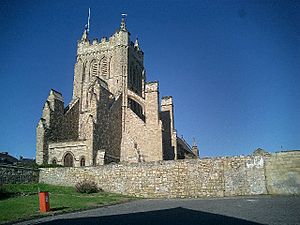
After the Norman Conquest, the De Brus family took control of the land around Hartlepool. William the Conqueror ordered Durham Castle to be built. In 1153, Robert de Brus, 1st Lord of Annandale became the Lord of Hartness. Hartlepool got its first official document (charter) before 1185. This gave it its first mayor, a two-week fair each year, and a weekly market. The Norman influence changed the name to Hart-le-pool, meaning "The Pool of the Stags."
By the Middle Ages, Hartlepool was a growing market town. Its harbour was the official port for the County Palatine of Durham, a special area ruled by the Bishop of Durham. Fishing was the main industry, and Hartlepool became one of England's most important ports on the East coast.
In 1306, Robert the Bruce became King of Scotland and the last Lord of Hartness. King Edward I of England took control of Hartlepool and started to improve its defenses. In 1315, a Scottish army led by Sir James Douglas attacked and robbed the town before the defenses were finished.
In the late 1400s, a pier was built to help with the busy harbour.
Military Defenses and Spa Town
Hartlepool was taken over by a Scottish army again during the English Civil War. This time, they were working with the English Parliament's army. After 18 months, an English Parliamentarian army took over.
In 1795, Hartlepool built artillery posts and defenses to protect against attacks from French ships during the Napoleonic Wars. During the Crimean War, two coastal batteries were built in the town to guard against the Russian Navy. These were called the Lighthouse Battery (1855) and the Heugh Battery (1859).
In the 1700s, Hartlepool became known for its healing springs, especially the Chalybeate Spa. The poet Thomas Gray visited in 1765 to "take the waters" and loved the place, calling its walks, rocks, and caves "finest."
Growth of West Hartlepool
By the early 1800s, Hartlepool was still a small town with about 900 people and a shrinking port. In 1823, leaders decided the town needed new industries. They planned a new railway to make Hartlepool a coal port, shipping coal from the Durham coal fields. Famous engineer Isambard Kingdom Brunel visited in 1831.
However, other new ports were being built nearby. To the north, Seaham Harbour opened in 1831. To the south, the Clarence Railway connected to Port Clarence in 1833. Even further south, the Stockton and Darlington Railway reached Middlesbrough in 1831.
To compete, the council agreed to form the Hartlepool Dock and Railway Company (HD&RCo). This company would expand the port and connect it to coal mines and the railway network. Christopher Tennant started the HD&RCo in 1833. His plan was to build a new railway, the Stockton and Hartlepool Railway, to link to the Durham coalfield.
After Tennant died, Ralph Ward Jackson took over in 1839. He was frustrated by rules in old Hartlepool, so he bought land to the south-west, mostly sand dunes, and started West Hartlepool. Jackson was very successful at shipping coal from West Hartlepool. As ships got bigger, the new town quickly grew much larger than the old one.
The West Hartlepool Harbour and Dock opened in 1847. In 1852, the Jackson Dock opened, and a railway connected West Hartlepool to Leeds, Manchester, and Liverpool. This allowed coal and wool to be shipped east, and fish and raw wool to be shipped west. This helped the town grow even more. The Swainson Dock opened in 1856. In 1878, the William Gray & Co shipyard in West Hartlepool built more ships by weight than any other shipyard in the world. By 1881, old Hartlepool had 12,361 people, but West Hartlepool had 28,000.
Ralph Ward Jackson helped design West Hartlepool. He was also involved in setting up its first public buildings, schools, and helping the people who lived there.
World Wars and Changes
First World War
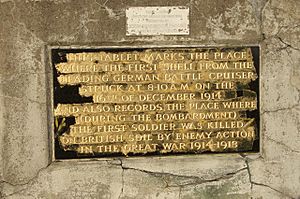
Hartlepool became a major industrial area with an ironworks (from 1838) and shipyards (from the 1870s). By 1913, 43 shipping companies were in the town, owning 236 ships. This made it an important target for Germany in the First World War. On December 16, 1914, the Imperial German Navy attacked Hartlepool.
Hartlepool was hit by 1,150 shells, killing 117 people. Two coastal defense batteries in Hartlepool fired back, launching 143 shells. They damaged three German ships: SMS Seydlitz, SMS Moltke, and SMS Blücher. The battle lasted about 50 minutes.
Private Theophilus Jones, a soldier, died in this attack. He is sometimes called the first military person killed on British soil by enemy fire. A memorial and a plaque remember this event. People from Hartlepool gave more money per person to the war effort than any other town in Britain.
Between the Wars On January 4, 1922, a fire in a timber yard left 80 people homeless and caused a lot of damage. Hartlepool suffered greatly during the Great Depression of the 1930s, with many people out of work.
Second World War Unemployment went down during the Second World War. Shipbuilding and steel-making industries became busy again. Most of the ships built were "Empire Ships." German bombers attacked the town 43 times. However, fewer civilians died compared to the previous war. RAF Greatham, an air force base, was also located near the town.
The Towns Merge
In 1891, the two towns had a total population of 64,000. By 1900, the two Hartlepools together were one of the three busiest ports in England.
The modern town is a combination of "Old Hartlepool," known as the "Headland," and West Hartlepool. West Hartlepool grew to be the larger town. They officially joined in 1967. Today, the name "West Hartlepool" is rarely used, except in sports. For example, one of the town's Rugby Union teams still uses the name.
The town's professional football club, Hartlepool United, was formed in 1908. It was first called "Hartlepools United" to get support from both towns. When the towns merged in 1967, the club changed its name to "Hartlepool" and then back to "Hartlepool United" in the 1970s. Many fans still call the team "Pools."
Recent Times and Future Plans
After the Second World War, industries declined sharply. The last ship built in Hartlepool left the docks in 1961. In 1970, the Middleton Grange Shopping Centre opened, bringing over 130 new shops.
Before this, the old town centre was around Lynn Street. But by 1974, most shops had moved to the new centre. Much of Lynn Street was then taken down to build new homes.
In 1977, the British Steel Corporation closed its Hartlepool steelworks, causing 1,500 job losses. In the 1980s, unemployment was very high, reaching 30% of the town's working population. This was the highest in the United Kingdom. In total, 10,000 jobs were lost as industries closed down.
However, things started to improve. Docks near the town centre were rebuilt and reopened by Queen Elizabeth II in 1993 as a marina. The National Museum of the Royal Navy opened in 1994.
There are plans for future projects, focusing on the railway station, the waterfront (including the Royal Navy Museum and a new leisure centre), and Church Street. The Northern School of Art also has money for new TV and film studios.
How Hartlepool is Governed
Hartlepool is run by one main local government body: Hartlepool Borough Council. There is also a local council for the Headland area. The borough council is part of the Tees Valley Combined Authority, which is led by the Tees Valley Mayor. The main council office is at the Civic Centre on Victoria Road.
Hartlepool was an old town with its own rules, getting a special document from King John in 1200. It became a municipal borough in 1850. The council built Hartlepool Borough Hall as its main office in 1866.
West Hartlepool was built on land outside old Hartlepool's original boundaries. In 1854, a group of commissioners was set up to manage the new town. In 1887, West Hartlepool also became a municipal borough. Its council built its headquarters at the Municipal Buildings on Church Square in 1889. In 1902, West Hartlepool became a county borough, meaning it was independent from Durham County Council. The old Hartlepool council and West Hartlepool council joined in 1967 to form one county borough called Hartlepool.
In 1974, the borough grew to include eight nearby areas. It became part of the new county of Cleveland. Cleveland was later removed in 1996, and Hartlepool became a unitary authority, independent from Durham County Council. For official ceremonies, it is still considered part of County Durham.
Local Council Wards
After changes in 2019, Hartlepool is divided into 12 voting areas, called wards. Each ward elects three councillors, making up the 36 councillors of the borough council.
| Burn Valley | De Brus | Fens & Greatham | Foggy Furze |
| Hart | Headland & Harbour | Throston | Manor House |
| Rural West | Seaton | Victoria | Rossmere |
Members of Parliament
Hartlepool has one Member of Parliament (MP) who represents it in the House of Commons. The current MP for the Hartlepool constituency is Jonathan Brash from the Labour Party. He was elected in the 2024 general election.
MPs for Hartlepool since 1945 have included:
| Colour key |
|---|
| Name | Term of office | Political party | Offices held | |
|---|---|---|---|---|
| David Thomas Jones | 1945–1959 | Labour | ||
| John Simon Kerans | 1959–1964 | Conservative | ||
| Edward Leadbitter | 1964–1992 | Labour | ||
| Peter Mandelson | 1992–2004 | Labour | Secretary of State for Northern Ireland (1999–2001), Secretary of State for Trade and Industry (1998), Minister without Portfolio (1997–1998) |
|
| Iain Wright | 2004–2017 | Labour | Parliamentary Under Secretary of State for 14–19 Reform and Apprenticeships (2009–2010) | |
| Mike Hill | 2017–2021 | Labour | ||
| Jill Mortimer | 2021–2024 | Conservative | ||
| Jonathan Brash | 2024– | Labour | ||
Peter Mandelson, who was MP from 1992 to 2004, left to work for the European Commission. In 2008, he was given the title Baron Mandelson of Foy and Hartlepool when he became a government minister.
Emergency Services
Hartlepool is covered by Cleveland Fire Brigade and Cleveland Police. Before 1974, it was part of the Durham Constabulary and Durham Fire Brigade. Hartlepool has two fire stations: one full-time and one part-time on the Headland.
Geography of Hartlepool
Distances to Other Places
| Place | Distance | Direction | Relation |
|---|---|---|---|
| Darlington | 18 miles (29 km) | South west | Part of the Combined Authority area |
| Sunderland | 17 miles (27 km) | North | Largest town in the historic county of Durham |
| Durham | 16 miles (26 km) | North | Historic county town and closest city |
| Stockton | 9 miles (14 km) | South west | Part of the Combined Authority area |
| Middlesbrough | 8 miles (13 km) | South | Part of the Combined Authority area |
Nearby towns include Seaham (17 miles), Sedgefield (13 miles), Billingham (8 miles), and Peterlee (8 miles). On clear days, you can see the distant monument on Eston Nab across the Tees Bay.
Hartlepool's Economy
Hartlepool's economy has always been connected to the sea. This is still important for local businesses. The Hartlepool Dock is owned by PD Ports. About 1,700 people work in engineering jobs. Tata Steel Europe employs about 350 people making steel tubes, mainly for the oil industry. South of the town, Able UK runs a large marine recycling facility called TERRC. Next to it is the Hartlepool nuclear power station, which opened in the 1980s. It is the biggest employer in town, providing 1% of the jobs for working-age people.
The chemicals industry is also important. Companies like Huntsman Corporation make titanium dioxide for paints.
Tourism brought in £48 million to the town in 2009. Hartlepool's history with the sea is shown at the Maritime Experience. This includes exhibits like the ship PS Wingfield Castle and HMS Trincomalee.
Camerons Brewery started in 1852 and employs about 145 people. It is one of the biggest breweries in the UK. It makes its own beers like Strongarm and also brews popular beers like Kronenbourg 1664 and John Smith's for other companies.
Orchid Drinks, a soft drinks company, was formed in Hartlepool in 1992. They made drinks like Purdey's. The company was bought by Britvic in 2009, and the Hartlepool site closed.
Middleton Grange Shopping Centre is the main shopping area. About 2,800 people work in retail. Major shops include Tesco, Morrisons, Asda, Next, Argos, Marks & Spencer, Aldi, Boots, and Matalan. For entertainment, there's a VUE Cinema and Mecca Bingo.
Companies like Siemens and Van Oord have moved to Hartlepool to work on offshore wind farm projects.
Culture and Community in Hartlepool
Festivals and Fairs
Since 2014, the Headland has hosted the annual Wintertide Festival. This weekend event starts with a parade on Friday and ends with a performance and fireworks on Sunday.
Tall Ships' Races
On June 28, 2006, Hartlepool won its bid to host The Tall Ships' Races. The town welcomed up to 125 tall ships in 2010. Hartlepool was the finishing point for the race, which started in Norway. Hartlepool also hosted the race in July 2023.
Museums, Art Galleries, and Libraries
Hartlepool Art Gallery is in Church Square, inside Christ Church. This is a restored Victorian church built in 1854. The gallery often changes its temporary exhibitions, showing works from local artists and its own art collection. It also has the Hartlepool tourist information centre.
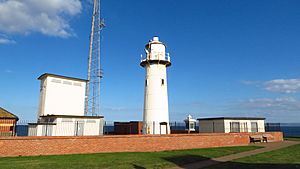
The Heugh Battery Museum is on the Headland. It was one of three batteries built in 1860 to protect Hartlepool's port. The battery closed in 1956 and is now a museum with an artillery collection.
Hartlepool is home to a National Museum of the Royal Navy (specifically the NMRN Hartlepool). It used to be called The Historic Quay. The museum shows what an 18th-century seaport was like. Its main attraction is a sailing frigate, HMS Trincomalee. The museum also includes the Museum of Hartlepool.
Willows was the large house of Sir William Gray, a very important person from William Gray & Company. He gave it to the town in 1920. It became the town's first museum and art gallery, known locally as "The Gray." It closed as a museum in 1994 and now houses the local council's culture department.
There are six libraries in Hartlepool. The main one is the Community Hub Central Library. Others include Throston Grange, Community Hub North, Seaton Carew, Owton Manor, and Headland Branch Library.
Transport in Hartlepool
Roads
Hartlepool is served by two main roads: the A179 road and the A689 road. Both connect the town to the A19 road. The A179 goes north-west towards the A19, Durham, Sunderland, and Tyneside. The A689 goes south-west towards the A19, Billingham, Stockton, Middlesbrough, and York. The A178 road goes south to Seaton Carew and Middlesbrough. The A1086 road goes north to Crimdon and Peterlee.
Trains
Hartlepool has two train stations: Hartlepool and Seaton Carew. Both are on the Durham Coast Line. Trains run hourly to Sunderland, Newcastle, and Middlesbrough, operated by Northern. There is also a direct train service to London King's Cross from Sunderland, run by Grand Central. This train uses fast Class 180 trains. This is the first time since the 1980s that Hartlepool has had a direct train link to London, which takes about three and a half hours.
Buses
Local bus services are mainly provided by Stagecoach North East. They have a service (36) from Hartlepool to Billingham, Stockton, and Middlesbrough. There's also a faster service (1) to Middlesbrough via Seaton Carew.
Other bus services are provided by Arriva North East. These go from Hartlepool to Peterlee, Durham, Seaham, and Sunderland.
Sea Transport
Hartlepool has been a major seaport almost since it was founded. It has a long history of fishing. During the industrial revolution, huge new docks were built. This led to the creation of the town of West Hartlepool.
Today, the docks are still used and can handle large ships. They are owned by PD Ports. A big part of the old dockland was turned into a marina. This marina can hold 500 boats. Hartlepool Marina is home to many pleasure boats and working ships, with a lock to get to and from the sea.
Hartlepool also has a permanent RNLI lifeboat station, which helps people in trouble at sea.
Education in Hartlepool
Secondary Schools
Hartlepool has five secondary schools:
- Dyke House Academy
- English Martyrs School and Sixth Form College
- High Tunstall College of Science
- Manor Community Academy
- St Hild's Church of England School
Colleges
Hartlepool College of Further Education is in the town centre. Its new £52 million building opened in 2011.
Hartlepool also has Hartlepool Sixth Form College. It offers courses for students aged 16-18. English Martyrs School and Sixth Form College also provides courses for this age group.
A campus of The Northern School of Art is a special college for art and design. It is next to the art gallery. It also has another site in Middlesbrough.
Religion in Hartlepool
There are many Church of England and Roman Catholic churches in Hartlepool. St Hilda's Church is very well known. It was built on the site of Hartlepool Abbey on a high point of the Headland. St Paul's Church (Church of England) and St Joseph's Church (Roman Catholic) are next to each other on St Paul's Road. Nasir Mosque on Brougham Terrace is the only mosque built specifically as a mosque in the town.
| Church Type | Belongs to | Examples of Churches |
|---|---|---|
| Church of England | Deanery of Hartlepool Archdeaconry of Auckland Diocese of Durham Province of York |
Christ Church (no longer used as a church) Holy Trinity St Aidan St Columba St Hilda St Luke St Oswald St Paul |
| Roman Catholic | Holy Family parish Hilda partnership Diocese of Hexham and Newcastle Archdiocese of Liverpool |
St Cuthbert St John Vianney St Joseph St Patrick St Thomas More St Mary |
Sports in Hartlepool
Football
Hartlepool United is the town's professional football club. They play at Victoria Park. A famous moment for the club was in 2005. With only 8 minutes left in a big play-off final, they gave away a penalty. This allowed Sheffield Wednesday to score and eventually beat Hartlepool, stopping them from moving up to a higher league. The club currently plays in the National League.
Hartlepool United also has a women's team called Hartlepool United FC Women. They started in 2015 and play in the North East Regional Women's Football League.
Fans of Hartlepool United are sometimes called "Monkey Hangers." This comes from a local legend about a monkey (see the "Monkeys" section below). Football presenter Jeff Stelling is from Hartlepool and is a big fan of the club. He often talks about them on Sky Sports News. Pete Donaldson, a radio DJ and podcast host, also grew up in Hartlepool.
The town also has a semi-professional football club called FC Hartlepool. They play in the Northern Football League Division Two.
Rugby Union
Hartlepool has many rugby clubs for a town its size. These include West Hartlepool, Hartlepool Rovers, and others. Since 1904, clubs within 8 miles of the Headland have competed for the Pyman Cup.
Perhaps the most famous club is West Hartlepool R.F.C.. In 1992, they were promoted to the top league, the Premiership. However, they later faced financial problems and had to sell their stadium.
Hartlepool Rovers, formed in 1879, played at the Old Friarage before moving to West View Road. In the 1890s, many Rovers players played for county and international teams. The club hosted important matches, including the first Barbarians F.C. match in 1890, and games against the Māori All Blacks in 1888 and the famous All Blacks in 1905. In the 1911–12 season, Hartlepool Rovers set a world record for the most points scored in a season.
Other Sports
Hartlepool Cricket Club plays at Park Drive.
Hartlepool Caledonians & Billingham Hockey Club is a field hockey club that plays in the Yorkshire and North East Hockey League.
Olympics
Boxing
At the 2012 Summer Olympics, 21-year-old Savannah Marshall from Hartlepool competed in women's boxing. She lost in her first fight. Savannah Marshall is now a professional boxer and became the WBO female middleweight champion in 2020.
Swimming
In August 2012, Jemma Lowe, a British record holder from Hartlepool, competed in the 2012 Olympic Games. She finished sixth in the 200-metre butterfly final. She was also part of the British team in the 400m Medley relay.
The Hartlepool Monkeys Legend
Hartlepool is famous for a story about a monkey. The legend says that during the Napoleonic Wars, a French warship sank off the coast. The only survivor was a monkey, dressed in a French military uniform. Fishermen from Hartlepool thought the monkey was a French spy. After a quick "trial," they executed the monkey.
Historians say there's a similar Scottish folk song. It tells of a monkey surviving a shipwreck near Boddam in Scotland. The villagers supposedly killed the monkey so they could claim money for the wreck, as they could only do so if there were no survivors. There is also an English folk song about the Hartlepool event, called "The Hartlepool Monkey." In this version, the monkey is killed because it's thought to be a French spy.
"Monkey hanger" is a nickname for people from Hartlepool, often used in a friendly way by rival football fans. The mascot of Hartlepool United F.C. is H'Angus the monkey. The person inside the monkey costume, Stuart Drummond, even ran for mayor in 2002 as H'angus the monkey. He promised free bananas for schoolchildren. Surprisingly, he won, becoming the first directly elected mayor of Hartlepool. He was re-elected by a large number of votes in 2005.
The monkey legend is also linked to two of the town's rugby clubs. Hartlepool Rovers RFC uses a hanging monkey as its club logo. Hartlepool (Old Boys) RFC uses a hanging monkey kicking a rugby ball as its crest.
Famous People from Hartlepool
Many notable people are from Hartlepool or have lived there:
- Michael Brown, a former professional footballer.
- Brian Clough, a famous football manager.
- Pete Donaldson, a radio DJ and podcast host.
- Janick Gers, guitarist for the heavy metal band Iron Maiden.
- Courtney Hadwin, a singer.
- Andy Linighan, a former Arsenal footballer.
- Savannah Marshall, a professional boxer.
- Jim Parker, a composer.
- Guy Pearce, a film actor who lived in the town when he was younger.
- Jack Rowell, who coached the England rugby team.
- Wayne Sleep, a dancer and actor who spent his childhood in the town.
- Reg Smythe, the cartoonist who created Andy Capp.
- Jeremy Spencer, a guitarist who was in the original Fleetwood Mac band.
- Jeff Stelling, a TV presenter famous for hosting Gillette Soccer Saturday.
Local Media in Hartlepool
- Hartlepool Life - a free local newspaper.
- Hartlepool Mail – a local newspaper.
- BBC Radio Tees – a local radio station from the BBC.
- Radio Hartlepool – a local radio station for the town.
- Hartlepool Post – an online publication.
- Local TV news programmes are BBC Look North and ITV News Tyne Tees.
Twin Towns
Hartlepool is twinned with:
- Sète, France
- Hückelhoven, Germany (since 1973)
- Muskegon, Michigan, United States
- Sliema, Malta
Images for kids
See also
 In Spanish: Hartlepool para niños
In Spanish: Hartlepool para niños


